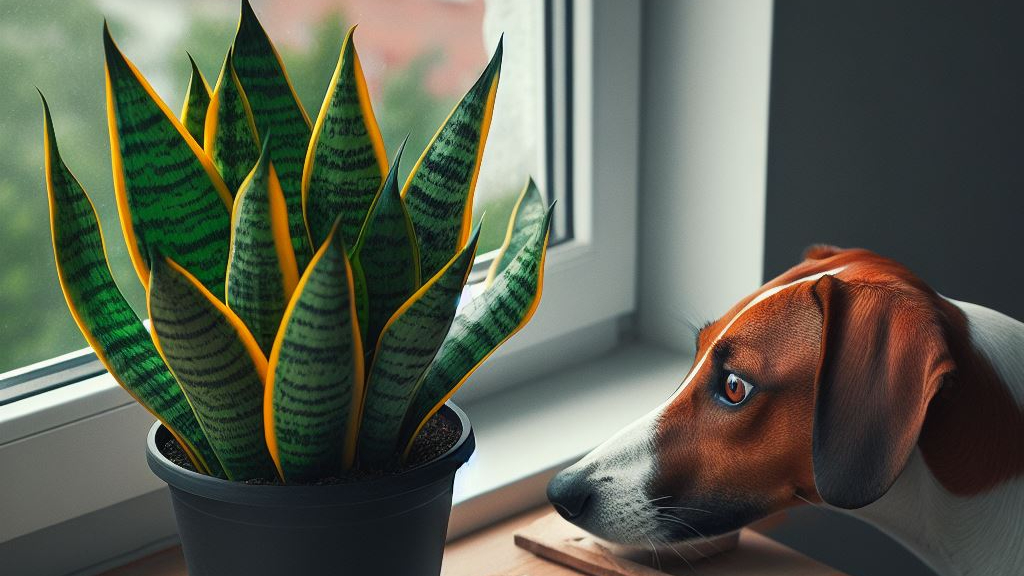Last updated on March 21st, 2024 at 02:05 pm
Snake plants, scientifically known as Sansevieria trifasciata, are awesome indoor plants known for their tall, upright leaves and their knack for thriving anywhere. People love them for keeping the air fresh and needing very little attention, making them super popular in homes.
However, it’s important to note that snake plants are toxic for dogs, causing potential harm if ingested by our furry friends. Pet owners, especially those with dogs, often worry about the presence of these plants in their homes due to the potential risks they pose to their beloved animals.
Sansevieria trifasciata, with its long, thick leaves that resemble grass, is a plant that plant lovers and pet owners often question. They wonder, “Can Sansevieria trifasciata hurt cats and dogs?” Unfortunately, yes, they can. These plants contain something called saponin, which protects them from germs and bugs but can be harmful to pets.
As a pet owner, it’s essential to know that Sansevieria trifasciata, commonly known as snake plants, might not be safe for your pets. Snake plants are toxic for dogs, and understanding more about these plants is crucial to ensuring your pets stay out of harm’s way. Let’s discover more about these plants and how to ensure your pets stay safe, considering the potential risks posed by snake plants if ingested by dogs.
Contents
- 1 Snake Plants Origins and Unique Appearance
- 2 Benefits of snake plants
- 3 Dog-friendly or Snake Plants Are Toxic For Dogs? Myth Busting
- 4 Understanding the Impact of Saponins on Dogs
- 5 Snake Plants are toxic for dogs – Symptoms of Toxicity in Dogs
- 6 Preventing Dogs from Accessing Snake Plants:
- 7 Alternative Safe Plants for Dog Owners:
- 8 Grasping the Dangers and Getting Veterinary Help
- 9 FAQS
- 9.1 1- What other succulents, besides snake plants are toxic for dogs?
- 9.2 2- What should I do if my dog ingests a snake plant as snake plants are toxic for dogs?
- 9.3 3- Are snake plants toxic for dogs?
- 9.4 4- What are the symptoms of snake plant toxicity in dogs?
- 9.5 5- How can I prevent my dog from accessing snake plants?
- 10 Author
Snake Plants Origins and Unique Appearance
Originally from warm regions in Africa and Asia, Sansevieria trifasciata is a hit among newbie plant owners. Their long sword-shaped leaves come in a range of striking colors like dark green, light green, and grey-green, making them an eye-catching addition to any home. Additionally, these plants have a fascinating ability to survive in different conditions, making them quite remarkable.
Benefits of snake plants
Snake plants, often nicknamed mother-in-law’s tongue, are fantastic plants to have in your home for several compelling reasons. They’re not just visually appealing; they offer numerous advantages:
1- Improving Indoor Air Quality:
Snake plants excel at purifying indoor air by filtering out harmful toxins. They’re like nature’s own air purifiers, making the air cleaner and safer to breathe for everyone in the household.
2- Enhancing Mental Well-being:
These plants have a remarkable way of positively impacting mental health. Their presence can create a soothing and calming atmosphere, reducing stress and anxiety levels. Just having them around can make you feel more relaxed and at ease.
3- Defense Against Allergens:
Snake plants act as a shield against airborne allergens. They release moisture and oxygen into the air, helping to reduce the presence of allergens that might trigger allergies, thereby making the environment more comfortable for those prone to allergies.
4-Absorbing Negative Energy:
According to certain beliefs, snake plants have been associated with absorbing negative energy. While this claim might not be scientifically proven, many cultures believe in the plant’s ability to cleanse the surroundings from negative vibes, promoting a more positive and harmonious environment.
Overall, snake plants offer a range of benefits beyond just being lovely decorations. They contribute to a healthier and more pleasant living space, making them an excellent addition to any home. Along with these benefits, these plants are harmful to dogs.
Dog-friendly or Snake Plants Are Toxic For Dogs? Myth Busting

Are snake plants toxic for dogs or not? Unfortunately, they’re not safe for dogs. Snake Plants are known to be harmful to our furry friends. Snake plants are quite popular indoors because they look cool and are easy to care for. But if dogs eat them, it can lead to problems like throwing up, feeling sick, or having a runny tummy.
Snake plants have something called saponins, which can cause trouble for our dogs if they munch on them. While it’s rare for dogs to die from eating snake plants, they might feel uncomfortable or have a sore belly.
Even though these plants aren’t usually super dangerous, it’s smart to keep them away from where your dog can reach to make sure they stay happy and safe.
Understanding the Impact of Saponins on Dogs
Saponins are natural compounds found in snake plants that act as a defense mechanism for the plant. They’re like the plant’s bodyguards, protecting it from pests and diseases.
However, Snake Plants are toxic for dogs. If a dog eats any part of a snake plant, these saponins can cause irritation in the stomach lining and gastrointestinal tract. This irritation leads to discomfort for the dog, resulting in symptoms like vomiting, nausea, or diarrhea.
Now, onto the sap of the snake plant.
Snake Plants are toxic for dogs. This sticky substance found in the plant, if touched or ingested by dogs, can cause trouble. Imagine it as a natural glue for the plant. If a dog’s mouth, nose, or skin comes into contact with this sap, it can lead to irritation and inflammation. This might cause swelling, redness, and itching in the affected areas, leading to skin irritation or even dermatitis in more severe cases.
Understanding these specific compounds in snake plants helps us comprehend why they can be harmful to dogs. So, being aware of these potential effects can help pet owners take necessary precautions and keep their furry friends safe from any discomfort or health issues caused by snake plants.
Snake Plants are toxic for dogs – Symptoms of Toxicity in Dogs
Here are some straightforward signs indicating that snake plants are toxic for dogs.
1- Digestive Issues
Snake plants are toxic for dogs and if your dog munches on snake plant leaves or any part of the plant, they might show signs of an upset tummy such as excessive drooling, throwing up, or having diarrhea. These symptoms often indicate their stomach is upset due to the plant’s toxins.
2- Mouth Discomfort
Snake plants contain substances that can irritate your dog’s mouth. Keep an eye out for signs like pawing at their mouth frequently, smacking their lips, or avoiding eating or drinking. These behaviors may indicate that their mouth feels uncomfortable or painful.
3- Swelling and Redness
In some cases of snake plant poisoning, dogs may experience swelling or redness in and around their mouth, tongue, or throat. Changes in the appearance of their mouth, such as swelling or red patches, could be signs of a reaction to the plant’s toxins.
4- General Sickness and Fatigue
Dogs affected by snake plant toxins might show signs of feeling sick, including loss of appetite, nausea, or a decrease in energy levels. They might seem less active or uninterested in their usual activities, indicating a general feeling of unwellness.
5- Breathing Problems
While uncommon, severe allergic reactions to snake plants might lead to breathing difficulties in dogs. Watch for signs like labored breathing, wheezing, or unusual sounds while breathing, which could indicate a serious issue that needs immediate attention.
6- Rapid Heart Rate
In severe cases of snake plant poisoning, dogs might experience a faster or irregular heartbeat. You might observe their heart beating rapidly or notice unusual heart rhythms, which can be a serious symptom needing urgent veterinary care.
Regarding succulents toxic to dogs, it’s essential to note that while snake plants (Sansevieria) are mildly toxic, other succulents, like aloe vera and certain types of Euphorbia (such as the crown of thorns), can also be harmful to dogs if ingested. These succulents contain substances that may cause gastrointestinal upset, skin irritation, or other adverse reactions in dogs.
Always keep an eye on your dog’s behavior and health. If you suspect they’ve eaten any toxic plant or exhibit concerning symptoms, contacting your veterinarian promptly for guidance and appropriate treatment is crucial to ensure their well-being.
Preventing Dogs from Accessing Snake Plants:
1- Dog-Friendly Deterrents
Some things like pepper, vinegar, or citrus are disliked by dogs. Spraying these on the plant might keep your dog away as snake plants are toxic for dogs. However, these need reapplication after watering or rain as they wash off.
2- Keeping the Plant Safe
Placing the snake plant in high or hanging spots out of your dog’s reach can be effective. However, make sure the spot is suitable for the plant’s growth requirements.
3- Using Barriers
Creating a barrier, like a gate or door, can prevent your dog’s access to the plant. But this might limit your dog’s movement in that area.
4- Training Your Dog
Training your dog to avoid the plant is an option but could take time. Some dogs may learn better than others, especially if they already know commands. For younger dogs or puppies, this might not work as effectively.
Alternative Safe Plants for Dog Owners:

As snake plants are toxic for dogs, dog owners should consider using alternative safe plants for their indoor spaces.
1. Spider Plant:
Known for being easy to care for, likes indirect light, and is good at purifying the air.
2. Boston Fern:
Common and easy to manage, needs a bit more humidity, and is safe for pets.
3. Areca Palm:
Requires bright, indirect light, needs regular watering, and is safe for pets.
4. Bamboo Palms:
Low-maintenance, can tolerate low light, and safe for dogs.
5. African Violet:
Blooms flowers, prefers indirect light and is safe for pets.
6. Calathea:
Recognized for its colorful leaves, needs minimal light, prefers humidity, and is pet-safe.
7. Chinese Money Plant:
Needs moderate to bright light, and dry soil before watering, and is believed to bring good luck.
These alternative plant options cater to different preferences, offering safe choices for homes with dogs while maintaining a pleasant indoor environment.
Grasping the Dangers and Getting Veterinary Help

Understanding that snake plants are toxic for dogs is crucial for their well-being. Different plants have varying levels of toxicity, and dogs can react differently to them. If you suspect your dog has ingested or come in contact with a toxic plant like a snake plant, keep an eye out for signs of illness.
Symptoms range from digestive issues like vomiting or diarrhea to more severe problems like breathing difficulties or unusual behavior. If you notice concerning signs or are uncertain about a plant’s toxicity, seek advice from a vet.
Ensuring your dog’s health is a priority. If you believe your dog encountered a toxic plant like a snake plant, promptly contact a vet. Inform them about the plant and your dog’s symptoms. The vet might suggest inducing vomiting, administering charcoal to absorb toxins, or conducting tests to assess your dog’s well-being.
Acting swiftly matters when it comes to toxic plants and dogs. Immediate vet assistance can significantly aid your dog’s recovery. Even if your dog appears fine initially, delayed problems could arise. Therefore, if you’re worried, don’t hesitate to consult your vet. They’ll guide you to keep your furry friend safe and healthy.
FAQS
1- What other succulents, besides snake plants are toxic for dogs?
Snake Plants are toxic for dogs. Besides snake plants, some other succulents that are toxic to dogs include jade plants (Crassula ovata), aloe vera, Kalanchoe species, and Euphorbia species. Dog owners need to be aware of these plants’ toxicity and take precautions to keep them out of reach of their pets.
2- What should I do if my dog ingests a snake plant as snake plants are toxic for dogs?
If you suspect your dog has eaten a toxic plant like a snake plant or displays symptoms of toxicity, contact your veterinarian immediately. Inform them about the plant and your dog’s symptoms. The vet may recommend treatments like inducing vomiting, administering charcoal, or performing tests to assess your dog’s health.
3- Are snake plants toxic for dogs?
Yes, snake plants are toxic for dogs. These plants contain a substance called saponin, which, if ingested, may cause discomfort or illness in dogs.
4- What are the symptoms of snake plant toxicity in dogs?
Symptoms of snake plant toxicity in dogs include digestive issues like vomiting or diarrhea, mouth discomforts such as pawing at the mouth or avoiding food, swelling or redness around the mouth, general sickness or fatigue, breathing difficulties, and increased heart rate.
5- How can I prevent my dog from accessing snake plants?
To prevent dogs from reaching snake plants as snake plants are toxic for dogs, you can use dog-safe deterrents like pepper or citrus scents, place the plant in high or hanging spots out of your dog’s reach, use barriers like gates, or train your dog to avoid the plant. However, always ensure these methods are safe for both the plant and your pet.
While snake plants offer beauty and clean air, they can harm dogs if eaten. These plants contain substances that cause stomach issues, mouth discomfort, swelling, and sickness in dogs. It’s crucial for pet owners to know these dangers and take steps to keep snake plants away from their furry friends. Recognizing symptoms and seeking vet help if a dog chews or touches these plants is essential. By being cautious and knowing the risks, pet owners can create a safer space for their pets at home.


1 thought on “Snake Plants Are Toxic For Dogs Or Not?”